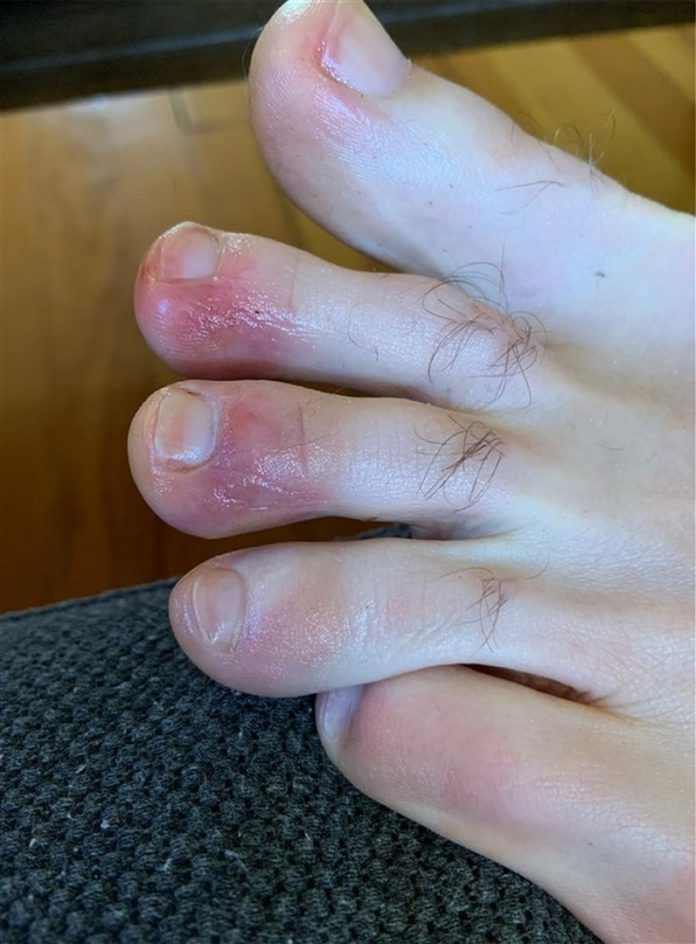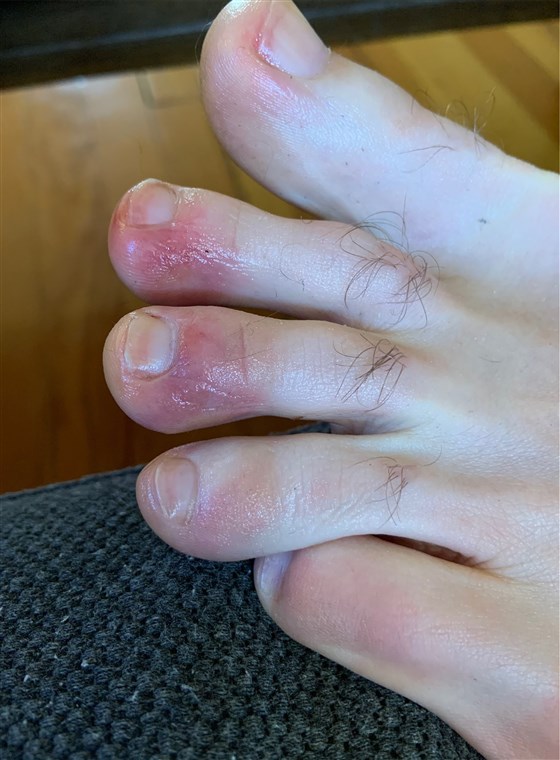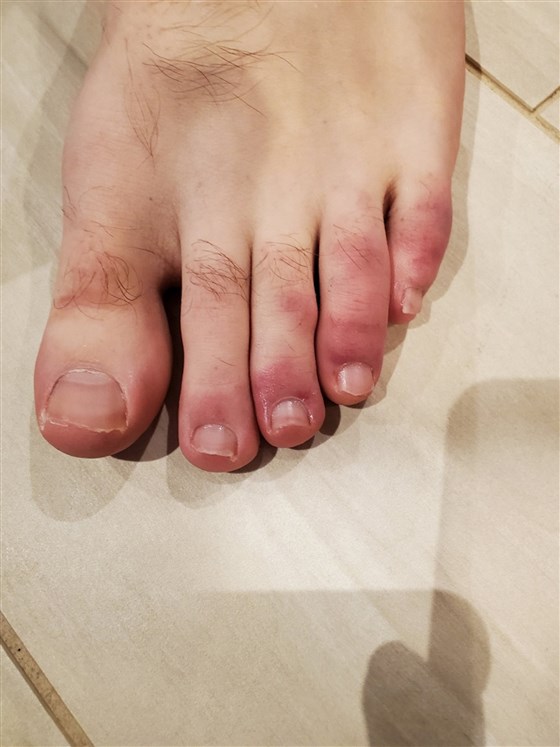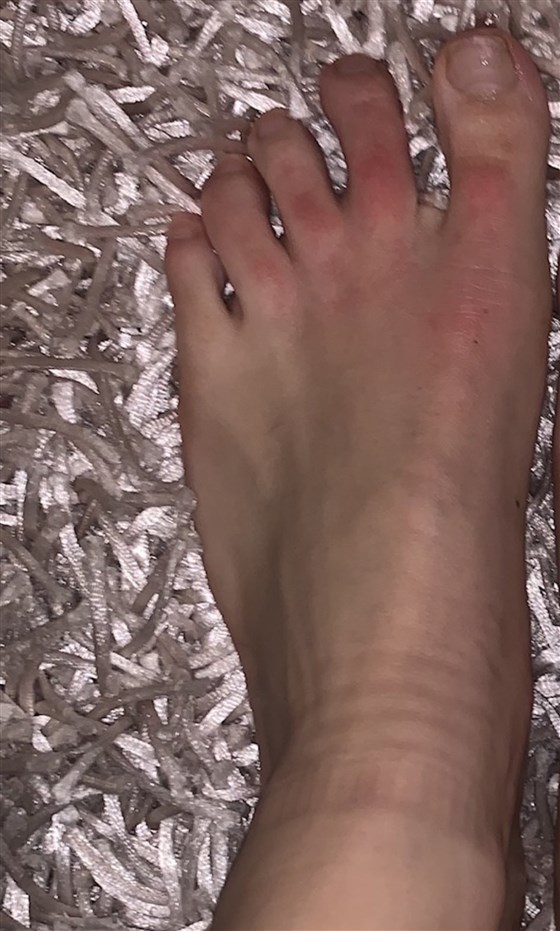
This skin condition could be the “new anosmia,” experts say, because it often appears in coronavirus patients without any other symptoms.
The longer the novel coronavirus circulates, the more unexpected symptoms pop up.
To name a few, ophthalmologists have said pink eye may be a rare sign of COVID-19, and anosmia, or a loss of smell, can occur in patients with no other symptoms. Coughing blood and tingling all over the body have also been reported.

Now, another condition possibly linked to the coronavirus has captured researchers’ attention.
Dubbed “COVID toes” by the dermatology community, it can look like “purple lesions” on feet or hands, Dr Esther Freeman, a dermatologist at Massachusetts General Hospital in Boston, told TODAY.
The research is ongoing and rooted in “observation,” Dr Tracey Vlahovic, associate professor of podiatry at Temple University in Philadelphia, told TODAY. “There’s no one-to-one correlation.”
But because COVID toes may appear before or without other coronavirus symptoms, Freeman believes it should be a criterion for testing. Dr Lindy Fox, professor of dermatology at University of California, San Francisco, agreed.
The condition usually starts with red or purple discoloration, and the skin may become raised or develop ulcerations, according to Dr Freeman. It can be on hands, too.
Fox told TODAY it has appeared as “purple, red bumps” on the tips of digits and pads, or on the tops of toes or sides of feet.
People with COVID toes may feel the skin is hot, burning or itchy.
One patient, David, 39, who didn’t want to share his last name, experienced possible COVID toes. He wasn’t tested for the virus, but told TODAY via email: “The affected toes were initially painful to touch and a bit sore while walking … The pain and soreness lasted just over one week and gradually went away.”

While other skin symptoms have appeared in COVID-19-positive patients, this one seems “COVID-specific,” Fox clarified. According to a case report from the European Journal of Pediatric Dermatology, the condition has “never been observed in the past.”
Again, the research is just beginning, but experts have some ideas.
“One hypothesis is there’s just a lot of inflammation caused by the virus,” Freeman said. The condition resembles pernio, caused by exposure to cold temperatures, resulting in inflammation which can appear as skin sores or bumps.

The other theory is that the symptom is due to blood vessel clots, which can occur in COVID-19 patients.
“I don’t feel comfortable saying it’s one or the other,” Freeman explained. “It could be a bit of both.”
It’s unclear how common COVID toes are — because it’s unclear what percentage of the U.S. population has the coronavirus, according to Dr Freeman.
To answer this question and others, Freeman is running an international registry to document COVID-19 patients’ range of dermatologic conditions. The registry, which launched last week in collaboration with the American Academy of Dermatology, includes reports of people who tested positive and those whose health care providers suspect are positive.
Of the 90 to 100 reports from the first week, Freeman said nearly half addressed patients with purple lesions on feet or hands. For some but not all patients, it was the only symptom.
“I wouldn’t take purple toes as meaning, ‘I’m definitely going to get sick’ or ‘I’m not going to get sick’,” she added.
Based on the current reports, the condition seems more common in children and young people, but it’s “not exclusive” to them, Fox said.
What’s the treatment for COVID toes?
For patients who aren’t experiencing “a lot of other symptoms, (the condition) tends to resolve on its own,” Freeman said, adding, “There’s not one particular treatment.”
If you notice discoloration on your feet or other hallmarks of COVID toes, contact a dermatologist and ask to be tested for COVID-19, she advised.
Vlahovic added that underlying conditions, like a drug reaction or connective tissue disorder, can have similar symptoms, so providers should get a complete medical history.
For patients experiencing discomfort, warming your digits might help, according to Fox.
“Some patients do well with topical steroids,” she continued. “Some physicians are prescribing aspirin. Since we really don’t understand, it’s hard to recommend therapy.”
What are other skin symptoms of COVID-19?
According to a statement from the AAD, “it is likely that (skin manifestations of COVID-19) exist — as they occur with other common viral infections — and are probably under-recognised.”
Fox, Freeman and Vlahovic cited these examples:
Bumps on extremities and the torso, which are common with viral infections
Vascular lesions on the hands, feet and buttocks of patients who are very sick
Ultimately, the importance of COVID toes doesn’t lie in the condition itself. Rather, it could help researchers better “understand how much disease is out there,” Fox said.
Freeman added that recognizing COVID toes and making it a testing qualifier might “change the course of someone’s care … You could be potentially infecting friends, neighbors without knowing it.”
Credit: Maura Hohman is a weekend editor for TODAY.com.

